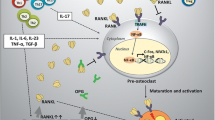Abstract
Objective: Endothelial dysfunction is considered a key factor in the development of cardiovascular diseases. Endothelial regeneration is necessary for the maintenance of endothelial function and circulating endothelial progenitor cells (EPC) participate of it in both direct and indirect manner. The molecular phenotype of EPC is not univocally defined and recent studies identified an osteocalcin (OCN)-positive (EPC-OCN+) subpopulation of EPC highly correlated with atherosclerosis progression. Aim: Considering that hypogonadism is a risk factor for cardiovascular diseases and atherosclerosis, we investigated the circulating levels of EPC-OCN+ in hypogonadal patients. Subjects and methods: Ten hypogonadotropic hypogonadal (HH) male patients and 30 healthy eugonadal men were evaluated for clinical status and hormonal levels. Circulating levels of CD34+/CD133+/kinase insert domain-receptor+ EPC and EPC-OCN+ were also determined by flow cytometry. Results: Compared to controls, HH patients displayed lower FSH, LH, estradiol, testosterone, and EPC levels. On the contrary, EPC-OCN + were significantly increased. Conclusions: The observed association of low levels of circulating EPC and increased values of EPC-OCN+ sub-population in hypogonadal men strengthens the significance of hypogonadism as cardiovascular risk factor.
Similar content being viewed by others
References
Cines DB, Pollak ES, Buck CA, et al. Endothelial cells in physiology and in the pathophysiology of vascular disorders. Blood 1998, 91: 3527–61.
Hirsch EZ, Chisolm GM 3rd, White HM. Reendothelialization and maintenance of endothelial integrity in longitudinal denuded tracks in the thoracic aorta of rats. Atheroscler 1983, 46: 287–307.
Hristov M, Weber C. Endothelial progenitor cells in vascular repair and remodeling. Pharmacol Res 2008, 58: 148–51.
Werner N, Kosiol S, Schiegl T, et al. Circulating endothelial progenitor cells and cardiovascular outcomes. N Eng J Med 2005, 353: 999–1007.
Hill JM, Zalos G, Halcox JP, et al. Circulating endothelial progenitor cells, vascular function, and cardiovascular risk. N Eng J Med 2003, 348: 593–600.
Fadini GP, Baesso I, Albiero M, Sartore S, Agostini C, Avogaro A. Technical notes on endothelial progenitor cells: Ways to escape from the knowledge plateau. Atherosclerosis 2008, 197: 496–503.
Eghbali-Fatourechi GZ, Mödder UI, Charatcharoenwitthaya N, et al. Characterization of circulating osteoblast lineage cells in humans. Bone 2007, 40: 1370–7. Erratum in: Bone 2007, 41: 741.
Gössl M, Mödder UI, Atkinson EJ, Lerman A, Khosla S. Osteocalcin expression by circulating endothelial progenitor cells in patients with coronary atherosclerosis. J Am Coll Cardiol 2008, 52: 1314–25.
Foresta C, De Toni L, Biagioli A, Ganz F, Magagna S, Caretta N. Increased levels of osteocalcin-positive endothelial progenitor cells in patients affected by erectile dysfunction and cavernous atherosclerosis. J Sex Med 2010, 7: 751–7.
Jialal I, Devaraj S, Singh U, Huet BA. Decreased number and impaired functionality of endothelial progenitor cells in subjects with metabolic syndrome: Implications for increased cardiovascular risk. Atherosclerosis 2010, Feb 4 [Epub ahead of print]; doi: 10.1016/j.atherosclerosis.2010.01.036.
Foresta C, Caretta N, Lana A, et al. Reduced number of circulating endothelial progenitor cells in hypogonadal men. J Clin Endocrinol Metab 2006, 91: 4599–602.
Ho CK, Stoddart M, Walton M, Anderson RA, Beckett GJ. Calculated free testosterone in men: comparison of four equations and with free androgen index. Ann Clin Biochem 2006, 43: 389–97.
Dockery F, Bulpitt CJ, Donaldson M, Fernandez S, Rajkumar C. The relationship between androgens and arterial stiffness in older men. J Am Ger Soc 2003, 51: 1627–32.
Alexandersen P, Haarbo J, Byrjalsen I, Lawaetz H, Christiansen C. Natural androgens inhibit male atherosclerosis: a study in castrated, cholesterol-fed rabbits. Circ Res 1999, 84: 813–9.
Kang SM, Jang Y, Kim JY, et al. Effect of oral administration of testosterone on brachial arterial vasoreactivity in men with coronary artery disease. Am J Cardiol 2002, 89: 862–4.
Khaw KT, Dowsett M, Folkerd E, et al. Endogenous testosterone and mortality due to all causes, cardiovascular disease, and cancer in men: European prospective investigation into cancer in Norfolk (EPIC-Norfolk) Prospective Population Study. Circulation 2007,116: 2694–701.
Foresta C, Ferlin A, De Toni L, et al. Circulating endothelial progenitor cells and endothelial function after chronic Tadalafil treatment in subjects with erectile dysfunction. Int J of Impot Res 2006, 18: 484–8.
Baba K, Yajima M, Carrier S, et al. Delayed testosterone replacement restores nitric oxide synthase-containing nerve fibres and the erectile response in rat penis. Brit J Urol Int 2000, 85: 953–8.
Bhasin S, Woodhouse L, Casaburi R, et al. Testosterone dose-response relationships in healthy young men. Am J Physiol 2001, 281: 1172–81.
Zitzmann M. Testosterone deficiency, insulin resistance and the metabolic syndrome. Nat Rev Endocrinol 2009, 5: 673–81.
Stein GS, Lian JB, van Wijnen AJ, Stein JL The osteocalcin gene: a model for multiple parameters of skeletal-specific transcriptional control. Mol Biol Rep 1997, 24: 185–96.
Author information
Authors and Affiliations
Corresponding author
Rights and permissions
About this article
Cite this article
Foresta, C., De Toni, L., Selice, R. et al. Increased osteocalcin-positive endothelial progenitor cells in hypogonadal male patients. J Endocrinol Invest 33, 439–442 (2010). https://doi.org/10.1007/BF03346620
Accepted:
Published:
Issue Date:
DOI: https://doi.org/10.1007/BF03346620




